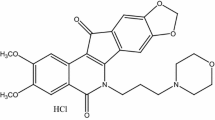Summary
Phyllanthoside is a naturally occurring glycoside with activity against IP transplantable murine tumors. Phyllanthoside administered IV, to mice at a nontoxic dose of 16 mg/kg could not be detected in blood or plasma even 30 s after administration. There was rapid formation of a less polar metabolite, which disappeared with a half-life of about 10 min. When phyllanthoside was administered as an IV bolus to beagle dogs at doses of 0.1, 0.5, and 3.0 mg/kg the mean half-life of phyllanthoside elimination from plasma was 1.3 min and total body clearance 85.8 ml min-1 kg-1. A second phase of elimination was seen but could not be accurately defined. Only trace amounts of the less polar metabolite were detected in dog plasma. Infusion of phyllanthoside to beagle dogs at doses of 0.5 and 3.0 mg/kg over 70 min gave values for an initial half-life of 0.3 and 0.6 min, a terminal half-life of 99.4 and 16.5 min, and a total body clearance of 11.2 and 49.2 ml min-1 kg-1, respectively. The highest nontoxi dose of phyllanthoside in dog was 0.1 mg/kg, while doses of 0.5 mg/kg and 3.0 mg/kg resulted in ataxia and death of the dog. There was no difference in toxicity to dog according to whether phyllanthoside was given by IV bolus or continuous infusion. Isolated hepatocytes from rat metabolized phyllanthoside at a rate of 4.4 μg/min per 106 cells to form the less polar metabolite. Coculture with isolated hepatocytes decreased the cytotoxicity of phyllanthoside to A204 human rhabdomyosarcoma cell line growing in soft agarose. It is suggested that rapid metabolism of phyllanthoside in mouse as against dog might account for the lower toxicity of phyllanthoside in mouse, and might also account for the reported poor antitumor activity of IV-administered phyllanthoside in the mouse.
Similar content being viewed by others
References
Alley MC, Powis G, Appel PL, Kooistra KL, Lieber MM (1984) Activation and inactivation of cancer chemotherapeutic agents by rat hepatocytes cocultured with human tumor cell lines. Cancer Res 44: 549
Ernster L, Siekvitz P, Palade G (1962) Enzyme-structure relationships in the endoplasmic reticulum of rat liver. J Cell Biol 15: 541
Metzler CM, Elfring G, McEwen AJ (1974) A package of computer programs for pharmacokinetic modeling. Biometrics 30: 562
Migdalof BH (1976) Methods for obtaining drug time course data from individual small animals: Serial microblood sampling and assay. Drug Metab Rev 5: 295
Pettit GR, Cragg GM, Gust D, Brown P, Schmidt JM (1982) The structures of phyllanthostatin 1 and phyllanthoside from the Central American tree Phyllanthus acuminatus Vahl. Can J Chem 60: 939
Pettit GR, Cragg GM, Niven ML, Nassimbeni LR (1983) Structure of the principla antineoplastic glycosides of Phyllanthus acuminatus Vahl. Can J Chem 61: 2630
Powis G, Moore DJ (1985) A high performance liquid chromatography assay for the antitumor glycoside phyllanthoside and its stability in plasma of several species. J Chromatogr 342: 129
Seidegard J, DePierre JW (1983) Microsomal epoxide hydrolase properties, regulation and function. Biochim Biophys Acta 695: 251
Stewart AJ, Inabe T (1976) N-Demethylation of aminopyrine in vivo and in the isolated hepatocyte of the rat. Biochem Pharmacol 28: 461
Wagner JG (1976) pharmacokinetic equations allowing direct calculation of many needed pharmacokinetic parameters from the coefficients and exponents of polyexponential equations which have been fitted to the data. J Pharma Biopharm 4: 443
Author information
Authors and Affiliations
Additional information
The work described in this paper was supported by NCI contract no. NO1-CM-37601
Preclinical Pharmacology Studies on Phyllanthoside (NSC 328426), National Cancer Institute, Bethesda, Md, USA (Dr J. A. R. Mead, personal communication November 21, 1984
Rights and permissions
About this article
Cite this article
Moore, D.J., Powis, G. Disposition and metabolism of the antitumor glycoside phyllanthoside in mouse and beagle dog. Cancer Chemother. Pharmacol. 16, 218–222 (1986). https://doi.org/10.1007/BF00293981
Received:
Accepted:
Issue Date:
DOI: https://doi.org/10.1007/BF00293981




